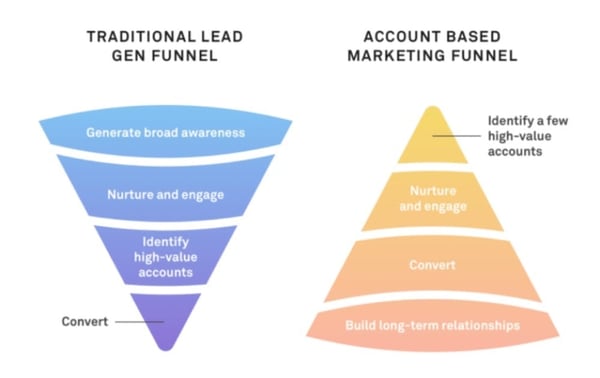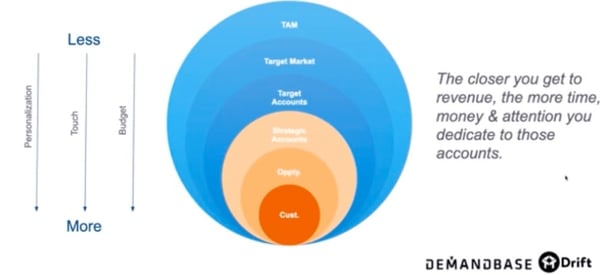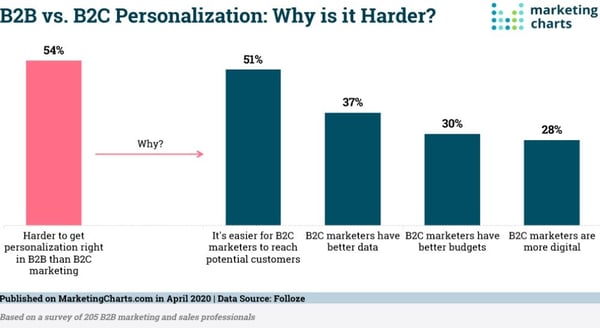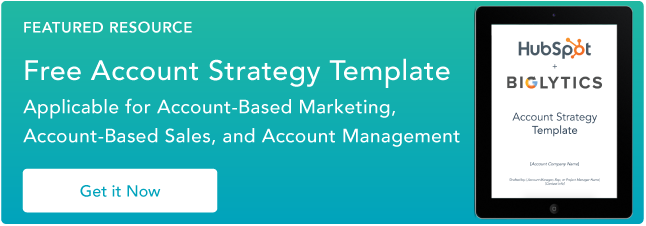In B2B sales, that means boosting conversion rates and landing more lucrative clients. Any new means of doing so or tools to assist the process are like gold dust for brands across all niches.
Leveraging a customer data platform (CDP) to support account-based selling is a prime example. It’s an effective way for businesses looking to sell to enterprises to boost their success rate. If you’re not yet up to speed on CDPs or account-based selling, it’s time to change that.
Personalization is a watchword in all modern sales environments. Account-based selling takes things to a new level. Ideal for landing enterprise-level clients, it’s a hyper-personalized sales technique. Departments across your firm work together. They target, reach out to, and land any account you’ve IDed as being high value.
Account-based selling typically encompasses all the following functions of your business:
- Marketing
- Sales
- Customer Success
- Executives & Board Members
The key to account-based selling is to take a unique approach to each target account. Your marketers and salespeople pinpoint vital stakeholders within the target company. They then reach out in a highly targeted and specific fashion.

All interactions and messages sent are highly personalized. At every stage, the focus is on the target account’s individual pain points or challenges. The means of communication must reflect the prospect’s preferences.
Executives at your firm may also interact personally with critical stakeholders of the target account. Then, once a client gets landed, your customer success team gets to work to deliver an equally unique onboarding experience.
There’s obviously more to account-based selling than we can cover here. What our summary should make clear, though, is the importance of data to the process. You can’t successfully target an account unless you know the prospect inside out. That brings us neatly onto customer data platforms (CDPs).
B2B Customer Data Platforms
CDPs are software solutions that are making a real splash in the sales and marketing sectors. They collect, unify, and aggregate all the customer data available to their owners. That means multiple data types, across many touch points, and gathered in real-time.
The types of customer data collected and organized by a CDP are namely:
- Identifying Data – Names of accounts and stakeholders; addresses; demographic details; etc.
- Descriptive Data – Deeper detail on stakeholders; career information; interests; etc.
- Behavioral Data – Interactions with your brand; purchases; website visits; email conversations; abandoned carts; phone calls; etc.
- Qualitative Data – How contacts learned about your brand; their opinions of you; NPS; etc.
A CDP, then, is a one-stop-shop for all customer data. It makes the information readily accessible to multiple business departments. More than that, too, CDPs structure the data in an actionable way. They build centralized, unique profiles for each customer or target account.
How to Leverage a CDP for Account-Based Selling
Now you know what account-based selling and CDPs are, it’s time to discuss how they intersect. For a brand looking to sell to enterprise-level clients, a CDP is an invaluable tool. In the same way that a robust SaaS SEO strategy is critical to growing sales in that niche, so too is a CDP to account-based selling.
The following are five of the principal ways a CDP can enhance your account-based approach to sales:
- Collecting and Unifying Data
- Qualifying and Targeting Accounts
- Timing Your Outreach
- Improving and Personalizing Interactions
- Streamlining Future Sales Processes
Collecting and Unifying Data
The first step to effective account-based selling is gaining a full understanding of a target account. For that, you need as much information as possible on your prospects. It’s only by collecting as much data as you can that you can accurately target and prioritize leads.

A customer data platform is a tool that can bring together all the relevant data. It will gather detail on:
- The specific pain points of customers and prospects
- How they have interacted with your brand
- Which communication channels they prefer
- Who the decision-makers are at each company
- When stakeholders have visited your website, and what they did
- At what times different contacts are most contactable
That’s only a taste of the information a CDP can collect. Those insights will also get captured by other systems, of course. Tools like Google Analytics or a CRM platform can gather some of them. Where a CDP stands out is that it unifies and organizes the data. Everything is available to all your business departments in one place.
Qualifying and Targeting Accounts
With so much data at your fingertips, qualifying and targeting accounts is far more straightforward. A CDP can help you pinpoint a smaller number of accounts with a higher chance of conversion. That allows your marketing and sales teams to better direct their time, effort, and budget.

For example, say that you want to target only companies of a specific size. You’re also only interested in those who have already shown an awareness of your brand. A CDP can collect behavioral data across multiple channels, such as your site, email, and ads. That may help you identify domains that have checked you out but not converted.
With a data enrichment tool, you can then learn more about the firm or individual behind the domain. You can find out their name, their niche, and their size. That, therefore, helps you to decide if they are a lead to target.
The above example is a simplistic explanation of the potential of CDPs. The platforms can help you segment prospects by many categories, including interactions, intent, and more. By enhancing account targeting in those ways, you boost your chances of turning leads into clients.
Timing Your Outreach
When you reach out to a prospect is almost as important as to whom you reach out. A correctly timed message or phone call can make all the difference in converting a lead into a customer. You need to hit a contact when they’re most likely to welcome your interaction and engage with you.
More than that, you must strike while the iron is hot. You need to know if a prospect is close to the purchase stage of their customer journey.
A customer data platform can help you find the right times to contact prospects. By collecting and analyzing customer data, it can alert you in real-time when an event occurs that makes outreach more viable. For instance, you can be notified if:
- Someone from a target account visits the pricing page of your website
- A stakeholder of a prospect spends a certain amount of time reading your content
- A lead begins a free trial or is approaching the end of said trial
Getting such alerts from your CDP is invaluable. They ensure you don’t miss any opportunities to convert prospects or nudge them further along your sales funnel. What’s more, the nature of the alert helps you make appropriate and relevant contact. Speaking of which…
Improving and Personalizing Interactions
Another key to successful account-based selling is relationship building. After you target an account, you must nurture your leads at that account. That's how you foster a strong connection. To do so, you need to have meaningful and productive conversations. CDPs can help here, too.
The data contained on the platforms gives you and your staff a 360-degree view of your prospects. With that, you can glean loads of useful insights about their needs and preferences. That lets you wholly personalize all your contact with them. Something that’s traditionally tougher in the B2B niche. We’re talking about the kind of personalization that sells, not just putting the right name at the top of an email.

The insights you glean will help your sales team hold proper, intelligent conversations. Rather than working from a sales script, you can engage with the prospect on a human level. You know what challenges they’re facing and how they do business. You can, therefore, tailor your approaches accordingly.
Streamlining Future Sales Processes
What we’ve covered so far is how CDPs can help you in the here and now. Another benefit of the platforms is that they can also streamline your future sales. That’s primarily because they can help you build better Ideal Customer Profiles (ICPs).
An ICP is your perfect customer. It’s the account that you dream of finding and targeting. Target such an account and your chances of conversion are much higher than trying to sell to just anyone. With a CDP, you can flesh out and finetune your ICPs like never before.
Thanks to all the data organized by the platform, you’ll know your present customers inside out. That makes it more straightforward to pinpoint their shared characteristics. That may be industry, company size, behavior, and more. All those will then also become aspects of your ICPS.
More accurate ICPs enable better account targeting. The targeting process becomes more streamlined, and it saves you both time and money. That’s not to mention the boost in conversion rates due to stripping out those leads which won’t go anywhere.
CDPs – A New Addition to Your Account-Based Selling Toolkit
Customer data platforms can be like a silver bullet for account-based selling. As a tool for collecting, unifying, and organizing customer data, they’re made for B2B selling. Building both trust and relationships, after all, is what B2B sales is all about. You can do neither without properly understanding your prospects.
With a CPD, getting to know your leads has never been simpler. You can use data from many sources to build a three-dimensional picture of each prospect. That makes it so much easier to engage and connect with them. It’s in that way that you can use a CDP to take your account-based selling to another level.
Account Based Sales
.png?width=112&height=112&name=Image%20Hackathon%20%E2%80%93%20Vertical%20(34).png)
.jpg)



